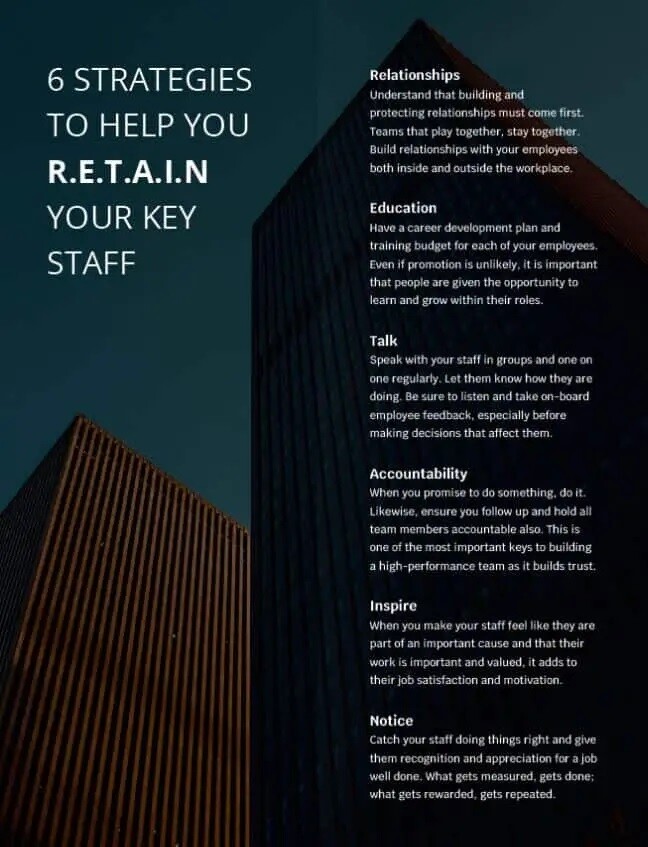“You just can’t expect loyalty from employees anymore,” is a common lament heard across many industries today and in my view, it’s entirely correct. However, the cause of reduced employee loyalty is not so much about the employees as it is about employers failing to recognise the needs and expectations of employees in a competitive global marketplace today. Loyalty can no longer be expected, rather, it must be earned.
LinkedIn did some interesting research with their Talent Trends 2014 survey which found that only 15% of employees are so satisfied with their roles that they are not open to looking at new employment opportunities. Fifteen years working as a business coach has taught me that any organisation with an employee turnover problem is one that has significant leadership and culture problems.
 With the cost of replacing employees estimated at around 1.5x their annual salary, it pays to retain great staff. In this article I’m going to outline what you can do and a simple R.E.T.A.I.N. formula to ensure you keep your best employees loyal to you and your business.
With the cost of replacing employees estimated at around 1.5x their annual salary, it pays to retain great staff. In this article I’m going to outline what you can do and a simple R.E.T.A.I.N. formula to ensure you keep your best employees loyal to you and your business.
Considering the Talent Trends data along with the latest Employee Exit Survey (also by LinkedIn) data shows that two thirds of employee turnover could be prevented by addressing three common issues causing employees to change jobs; a lack of advancement opportunities (22%), unsatisfactory leadership or senior management (19.5%) and experiencing a lack of challenge in their job (13.8%). All three of these reasons point directly back at issues with leadership and management. Let’s address each one of these in turn.
Issue #1: A Lack of Advancement Opportunities
Have you ever heard the phrase, “Perception is reality”? What I see in many businesses is managers so busy that they struggle to sit down once a year with their staff to review their performance and career goals. Employees adore managers who are prepared to say, “I believe in you” and help stretch their vision and create brightness of future for their career. Many managers also fail to create a career plan with milestones and goals to keep employees engaged and passionate in their roles.
As an employer, you need to encourage and support your employees in improving their skills and education. Prepare and invest in training your people to be ready to perform at the next level well before the job opening comes up. It really helps to have a “Hire from within” employee mobility policy that gives preference to your existing employees when applying for new roles that open up within your organisation. It’s a lot more inspiring for the team to see colleagues being promoted than new people being hired in from outside. This policy also protects and reinforces your company culture.
Issue#2: Unsatisfactory Leadership or Senior Management
Someone being a star performer in their allocated role does not mean that they are great management material. Technical skills and people skills lie at opposite ends of the behaviour spectrum and very few companies invest in grassroots level leadership programs to encourage and grow soft skills and leadership at all levels. Leadership programs tend to be reserved for senior managers, however by then, it is often too late.
Practicing any new skill without appropriate training creates bad habits and poor outcomes. Imagine giving your teenage children the keys to the car and telling them, “Give it a go, you’ll figure it out.” There’s a significant chance they will end up injuring themselves and any other unfortunate soul who gets in their way. The same is true for any employee or manager in your company that is promoted without adequate training. The casualties end up being your staff and your customers. Practice makes perfect only when the practice is performed correctly.
It is critical to regularly set aside time to engage with and listen to your employees. Ask them to rate your performance as their manager. When employees feel like management is listening, they feel valued and their motivation increases accordingly.
Issue#3: A Lack of Challenge in their Job
This is again where managers fail to really understand their employees or to challenge them with stretch goals or innovation projects. Any job can be fulfilling if the person understands the importance of what they are doing and receives recognition and appreciation from their colleagues and managers for a job well done. Implement data collection programs so you can regularly monitor how your employees are performing on key responsibilities.
Why not come up with some additional projects for your employees to work on in their spare time? Reward entrepreneurial thinking (or intrapreneurship) – your staff often know where the problems and opportunities lie within your business; if they can help you increase revenues or reduce costs, why would you not reward them accordingly? One example of this is the Whole Foods Market that gives their store managers an annual budget to test new ideas. One manager came up with the idea of building a craft beer tap room in their store and it became such a huge success it was rolled out to most of the stores across the network.
We Need to Address Changing Employee Expectations
The average employee entering the workforce today will work for more than 7 organisations over their working career. Employees (especially Gen Ys and Millennials) want to maximise their chances of remaining employable and obtaining career advancement, so they often look to work for multiple employers to rapidly grow their skill and knowledge base.
One of the unwritten rules of leadership (and life) is that you get what you give. The more value you give, the more value will come back in return. So you need to stop looking at your employees with the perspective of what they can give you. Instead, take some time to reflect on what value you can give to them.
Employees don’t leave companies, they leave their managers and colleagues. If you create an environment where employees enjoy coming to work, get the ability to use their skills in a meaningful way, AND are given the opportunity to learn, grow and master new skills then they are very unlikely to want to go anywhere else. If they do, they will quickly want to come back when they realise the many things they had been taking for granted working for your organisation.
So what does this mean in the context of increasing employee loyalty?
Leadership, pure and simple. As a leader you need to be able to articulate the vision of where your organisation is headed and the role that the team members need to play in making it a reality. You need to know your employees as individuals and to communicate the potential that you see within them and the career opportunities your organisation will provide them if they deliver on what is asked of them.Create a bright and compelling future that your team is excited about and they become self-motivated.
So here are six strategies that will help you R.E.T.A.I.N. your key staff
- Relationships – Understand that building and protecting relationships must come first. Teams that play together, stay together. Build relationships with your employees both inside and outside the workplace.
- Education – Have a career development plan and training budget for each of your employees. Even if promotion is unlikely, it is important that people are given the opportunity to learn and grow within their roles.
- Talk – Speak with your staff in groups and one on one regularly. Let them know how they are doing. Be sure to listen and take on-board employee feedback especially before making decisions that affect them.
- Accountability – When you promise to do something, do it. Likewise, ensure you follow up and hold all team members accountable also. This is one of the most important keys to building a high-performance team as it builds trust.
- Inspire – When you make your staff feel like that are part of an important cause and that their work is important and valued, it adds to their job satisfaction and motivation.
- Notice – Catch your staff doing things right and give them recognition and appreciation for a job well done. What gets measured gets done, what gets rewarded gets repeated.
You may notice that all of the six strategies outlined are related to communication. Great communication is delivered face to face, not via email. Technology has increased productivity but has failed to create the paperless office or to reduce employee workload. Employees now expect and demand more flexible work arrangements and it’s critical that you as a manager communicate effectively to understand their needs and balance this with your organisation’s needs to create a long lasting and mutually beneficial relationship for all parties.
Note: Article first published in PECB Insights Magazine, June 2019
If you’re looking for more ideas to improve employee engagement and loyalty click here, or call us today on 1800 330 027.



